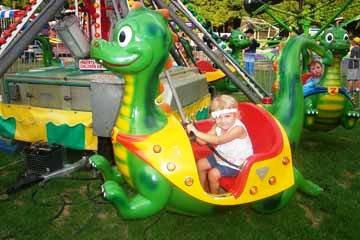[et_pb_text admin_label="Chris Fitzgerald byline; remember to tag post as various-contributors" saved_tabs="all" background_layout="light" text_orientation="left" header_font="Arimo||||" text_font="||on||" use_border_color="off" border_color="#ffffff" border_style="solid"]
When fair-goers enjoy the seventh annual Key Peninsula Community Fair over the weekend of July 13-15, it’s a pretty good bet no one will wonder how, why or when this extravaganza was created. It’s all part of the plan of a handful of longtime and new volunteers committed to making life on the KP unique, enjoyable, and memorable — without unduly calling attention to themselves.
 The rides are among the fair attractions, and this year the midway has been expanded. Photo by Kristen Pierce
The rides are among the fair attractions, and this year the midway has been expanded. Photo by Kristen Pierce
The KPCF is owned by three local nonprofits: KP Civic Center, KP Business Association, and Longbranch Improvement Club. The volunteers who create the fair every year are drawn from these organizations, or are individual community members giving back to their communities.
Since last October’s annual fair board meeting at which newly elected board members were seated, a new vision for the fair has been taking shape. Vice President Michael Hays says, “This group is working very well as a team.”
In the ensuing months, the board and its member affiliates have been meeting once to twice a month for meetings lasting one to three hours. Then, the wild ride behind the scenes begins. Six weeks prior to the fair, board and members (by now committees with details in tow) meet at least once a week, with a flurry of email, faxes and phone calls in-between. During fair “week” — those days before, during and after the event — most of these people work full time or more on fair projects, last-minute details, you-name-it. If it looks like a fair, smells like a fair, tastes like a fair, it’s because a lot of people devoted every waking hour, vacation-time and after-work time to making it happen.
“Nobody gets paid one penny. All this work is done on a volunteer basis, on behalf of the community,” Hays said.
All profits from the fair, other than some startup money for the following year, go back to the three nonprofit owner organizations. These are community support-based groups, and each equal one-third portion of proceeds eventually finds its way right back into the community in the form of services. And the cadre of volunteers “are doing this all for the enjoyment and support of our community, and nothing else,” Hays said.
This year’s fair is operating on a budget of a little more than $50,000, with expectations of a 20 percent net on those revenues, according to Hays.
The first year, the fair was about half the size it is now. In an email to the KP News, Hays wrote, “The fair made money its first year and continued to do so until last year, when it broke even.” He explained that last year was a “turn-around year when the fair invested pretty heavily to upgrade the product” including the entertainment and the midway. The board expects to show a “respectable” profit this year by creating an event that is fiscally viable, and a community showcase of talent, art, and regionally excellent entertainment.
UNDERWRITTEN BY THE FUND FOR NONPROFIT NEWS (NEWSMATCH) AT THE MIAMI FOUNDATION, THE ANGEL GUILD, ADVERTISERS, DONORS AND PEOPLE WHO SUPPORT INDEPENDENT, NONPROFIT LOCAL NEWS